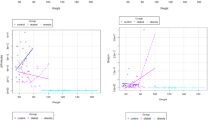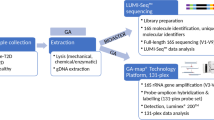Abstract
An association between type 2 diabetes mellitus (T2DM) and gut microbiota is well established, but the results of related studies are inconsistent. The purpose of this investigation is to elucidate the characteristics of the gut microbiota in T2DM and non-diabetic subjects. Forty-five subjects were recruited for this study, including 29 T2DM patients and 16 non-diabetic subjects. Biochemical parameters, including body mass index (BMI), fasting plasma glucose (FPG), serum total cholesterol (TC), triglycerides (TG), high-density lipoprotein (HDL), and hemoglobin A1c (HbA1c), were analyzed and correlated with the gut microbiota. Bacterial community composition and diversity were detected in fecal samples using direct smear, sequencing, and real-time polymerase chain reaction (PCR). In this study, it was observed that indicators such as BMI, FPG, HbA1c, TC, and TG in T2DM patients were on the rise, concurrent with dysbiosis of the microbiota. We observed an increase in Enterococci and a decrease in Bacteroides, Bifidobacteria, and Lactobacilli in patients with T2DM. Meanwhile, total short-chain fatty acids (SCFAs) and D-lactate concentrations were decreased in the T2DM group. In addition, FPG was positively correlated with Enterococcus and negatively correlated with Bifidobacteria, Bacteroides, and Lactobacilli. This study reveals that microbiota dysbiosis is associated with disease severity in patients with T2DM. The limitation of this study is that only common bacteria were noted in this study, and more in-depth related studies are urgently needed.




Similar content being viewed by others
Data Availability
The sequencing data have been deposited in the NCBI SRA database (http://www.ncbi.nlm.nih.gov/SRA/), BioProject accession PRJNA89876. All other data are included within the article or available from the authors upon request.
Code Availability
Not applicable.
References
Gaillard TR, Osei K (2016) Racial disparities in the pathogenesis of type 2 diabetes and its subtypes in the African diaspora: a new paradigm. J Racial Ethn Health Disparities 3:117–128. https://doi.org/10.1007/s40615-015-0121-z
Saeedi P, Petersohn I, Salpea P et al (2019) Global and regional diabetes prevalence estimates for 2019 and projections for 2030 and 2045: results from the International Diabetes Federation Diabetes Atlas, 9th edition. Diabetes Res Clin Pract 157:107843. https://doi.org/10.1016/j.diabres.2019.107843
Ding L, Xiao X-H (2020) Gut microbiota: closely tied to the regulation of circadian clock in the development of type 2 diabetes mellitus. Chin Med J 133:817–825. https://doi.org/10.1097/cm9.0000000000000702
Adak A, Khan MR (2019) An insight into gut microbiota and its functionalities. Cell Mol Life Sci 76:473–493. https://doi.org/10.1007/s00018-018-2943-4
Nagpal R, Yadav H (2017) Bacterial translocation from the gut to the distant organs: an overview. Ann Nutr Metab 71(Suppl 1):11–16. https://doi.org/10.1159/000479918
Fleissner CK, Huebel N, El-Bary MMA et al (2010) Absence of intestinal microbiota does not protect mice from diet-induced obesity. Br J Nutr 104:919–929. https://doi.org/10.1017/s0007114510001303
Gurung M, Li Z, You H et al (2020) Role of gut microbiota in type 2 diabetes pathophysiology. EBioMedicine 51:102590. https://doi.org/10.1016/j.ebiom.2019.11.051
Levin AM, Sitarik AR, Havstad SL et al (2016) Joint effects of pregnancy, sociocultural, and environmental factors on early life gut microbiome structure and diversity. Sci Rep 6:31775. https://doi.org/10.1038/srep31775
Wu X, Ma C, Han L et al (2010) Molecular characterisation of the faecal microbiota in patients with type II diabetes. Curr Microbiol 61:69–78. https://doi.org/10.1007/s00284-010-9582-9
Iatcu CO, Steen A, Covasa M (2021) Gut microbiota and complications of type-2 diabetes. Nutrients. https://doi.org/10.3390/nu14010166
Lee CB, Chae SU, Jo SJ et al (2021) The relationship between the gut microbiome and metformin as a key for treating type 2 diabetes mellitus. Int J Mol Sci. https://doi.org/10.3390/ijms22073566
Bordalo Tonucci L, Dos Santos KM, De Ferreira CLLF et al (2017) Gut microbiota and probiotics: focus on diabetes mellitus. Crit Rev Food Sci Nutr 57:2296–2309. https://doi.org/10.1080/10408398.2014.934438
Szliszka E, Czuba ZP, Domino M et al (2009) Ethanolic extract of propolis (EEP) enhances the apoptosis- inducing potential of TRAIL in cancer cells. Molecules 14:738–754. https://doi.org/10.3390/molecules
Salgaco MK, Oliveira LGS, Costa GN et al (2019) Relationship between gut microbiota, probiotics, and type 2 diabetes mellitus. Appl Microbiol Biotechnol 103:9229–9238. https://doi.org/10.1007/s00253-019-10156-y
Zhang W-Q, Zhao T-T, Gui D-K et al (2019) Sodium butyrate improves liver glycogen metabolism in type 2 diabetes mellitus. J Agric Food Chem 67:7694–7705. https://doi.org/10.1021/acs.jafc.9b02083
Qin J, Li Y, Cai Z et al (2012) A metagenome-wide association study of gut microbiota in type 2 diabetes. Nature 490:55–60. https://doi.org/10.1038/nature11450
Yan F, Li N, Shi J et al (2019) Lactobacillus acidophilus alleviates type 2 diabetes by regulating hepatic glucose, lipid metabolism and gut microbiota in mice. Food Funct 10:5804–5815. https://doi.org/10.1039/c9fo01062a
Turnbaugh PJ, Ley RE, Mahowald MA et al (2006) An obesity-associated gut microbiome with increased capacity for energy harvest. Nature 444:1027–1031. https://doi.org/10.1038/nature05414
Zhang X, Shen D, Fang Z et al (2013) Human gut microbiota changes reveal the progression of glucose intolerance. PLoS ONE 8:e71108. https://doi.org/10.1371/journal.pone.0071108
Mohamadshahi M, Veissi M, Haidari F et al (2014) Effects of probiotic yogurt consumption on inflammatory biomarkers in patients with type 2 diabetes. Bioimpacts 4:83–88. https://doi.org/10.5681/bi.2014.007
Xu T, Ge Y, Du H et al (2021) Berberis kansuensis extract alleviates type 2 diabetes in rats by regulating gut microbiota composition. J Ethnopharmacol 273:113995. https://doi.org/10.1016/j.jep.2021.113995
Cani PD, Amar J, Iglesias MA et al (2007) Metabolic endotoxemia initiates obesity and insulin resistance. Diabetes 56:1761–1772. https://doi.org/10.2337/db06-1491
Ni Y, Mu C, He X et al (2018) Characteristics of gut microbiota and its response to a Chinese herbal formula in elder patients with metabolic syndrome. Drug DiscovTher 12:161–169. https://doi.org/10.5582/ddt.2018.01036
Le TKC, Hosaka T, Nguyen TT et al (2015) Bifidobacterium species lower serum glucose, increase expressions of insulin signaling proteins, and improve adipokine profile in diabetic mice. Biomed Res 36:63–70. https://doi.org/10.2220/biomedres.36.63
Zhai L, Wu J, Lam YY et al (2021) Gut-microbial metabolites, probiotics and their roles in type 2 diabetes. Int J Mol Sci. https://doi.org/10.3390/ijms222312846
Ding Q, Zhang B, Zheng W et al (2019) Liupao tea extract alleviates diabetes mellitus and modulates gut microbiota in rats induced by streptozotocin and high-fat, high-sugar diet. Biomed Pharmacother 118:109262. https://doi.org/10.1016/j.biopha.2019.109262
Candela M, Biagi E, Soverini M et al (2016) Modulation of gut microbiota dysbioses in type 2 diabetic patients by macrobiotic Ma-Pi 2 diet. Br J Nutr 116:80–93. https://doi.org/10.1017/S0007114516001045
Sedighi M, Razavi S, Navab-Moghadam F et al (2017) Comparison of gut microbiota in adult patients with type 2 diabetes and healthy individuals. Microb Pathog 111:362–369. https://doi.org/10.1016/j.micpath.2017.08.038
Karlsson FH, Tremaroli V, Nookaew I et al (2013) Gut metagenome in European women with normal, impaired and diabetic glucose control. Nature 498:99–103. https://doi.org/10.1038/nature12198
Martinic A, Barouei J, Bendiks Z et al (2018) Supplementation of Lactobacillus plantarum improves markers of metabolic dysfunction induced by a high fat diet. J Proteome Res 17:2790–2802. https://doi.org/10.1021/acs.jproteome.8b00282
Lee E, Jung S-R, Lee S-Y et al (2018) Strain Ln4 attenuates diet-induced obesity, insulin resistance, and changes in hepatic mRNA levels associated with glucose and lipid metabolism. Nutrients. https://doi.org/10.3390/nu10050643
Balakumar M, Prabhu D, Sathishkumar C et al (2018) Improvement in glucose tolerance and insulin sensitivity by probiotic strains of Indian gut origin in high-fat diet-fed C57BL/6J mice. Eur J Nutr 57:279–295. https://doi.org/10.1007/s00394-016-1317-7
Okubo T, Takemura N, Yoshida A et al (2013) KK/Ta Mice Administered Lactobacillus plantarum Strain No. 14 Have Lower Adiposity and Higher Insulin Sensitivity. Biosci Microbiota Food Health. https://doi.org/10.12938/bmfh.32.93
Feizollahzadeh S, Ghiasvand R, Rezaei A et al (2017) Effect of probiotic soy milk on serum levels of adiponectin, inflammatory mediators, lipid profile, and fasting blood glucose among patients with type II diabetes mellitus. Probiotics Antimicrob Proteins 9:41–47. https://doi.org/10.1007/s12602-016-9233-y
Sharafedtinov KK, Plotnikova OA, Alexeeva RI et al (2013) Hypocaloric diet supplemented with probiotic cheese improves body mass index and blood pressure indices of obese hypertensive patients–a randomized double-blind placebo-controlled pilot study. Nutr J 12:138. https://doi.org/10.1186/1475-2891-12-138
Naruszewicz M, Johansson M-L, Zapolska-Downar D et al (2002) Effect of Lactobacillus plantarum 299v on cardiovascular disease risk factors in smokers. Am J Clin Nutr 76:1249–1255
Hütt P, Songisepp E, Rätsep M et al (2015) Impact of probiotic Lactobacillus plantarum TENSIA in different dairy products on anthropometric and blood biochemical indices of healthy adults. Benef Microbes 6:233–243. https://doi.org/10.3920/BM2014.0035
Acknowledgements
The authors are grateful for Xuhong Lin’s foundation and great technical support.
Funding
This work was supported by projects supported by the National Natural Science Foundation of China (No. 81500430 and No. U1304802), the Key Scientific Research Projects of Higher Education in Henan (No. 17A320019), and the Henan Science and Technology Planning Project (No. 182102310544 and No. 192102310045).
Author information
Authors and Affiliations
Contributions
XHL and QLH designed the study. XHL, QLH, HCW, YKM, RLY, ZFD, JNY, YX, DDW, and LPZ collected the samples and clinical information and analyzed the data. QLH, HCW, YKM, RLY, ZFD, and JNY analyzed and interpreted the data. XHL and QLH wrote and revised the manuscript. All authors had full access to the final version of the report and agreed to the submission.
Corresponding author
Ethics declarations
Conflict of interest
The authors have no conflict of interest to declare.
Ethical Approval
All human protocols of this study were approved by the ethics committee of Huaihe Hospital, Henan University, where the work was conducted, and this study complies with the Declaration of Helsinki with ethics approval number 2017111.
Consent to Participate
Written and verbal informed consent were obtained from all participants.
Consent for Publication
All participants provided consent to publish the results.
Additional information
Publisher's Note
Springer Nature remains neutral with regard to jurisdictional claims in published maps and institutional affiliations.
Supplementary Information
Below is the link to the electronic supplementary material.
Rights and permissions
Springer Nature or its licensor (e.g. a society or other partner) holds exclusive rights to this article under a publishing agreement with the author(s) or other rightsholder(s); author self-archiving of the accepted manuscript version of this article is solely governed by the terms of such publishing agreement and applicable law.
About this article
Cite this article
He, Ql., Wang, Hc., Ma, Yk. et al. Changes in the Microbiota and their Roles in Patients with Type 2 Diabetes Mellitus. Curr Microbiol 80, 132 (2023). https://doi.org/10.1007/s00284-023-03219-x
Received:
Accepted:
Published:
DOI: https://doi.org/10.1007/s00284-023-03219-x




